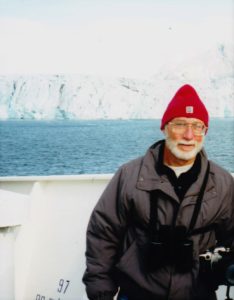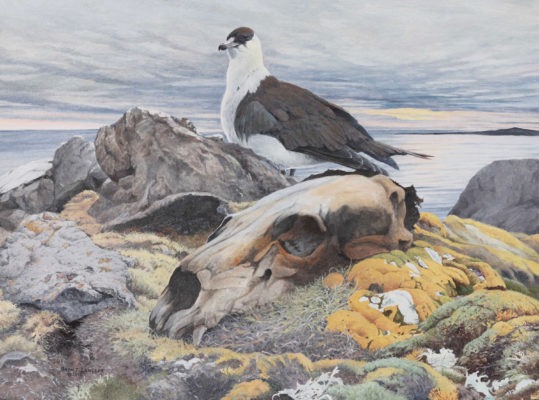The composition Arctic Twilight was inspired by a Sierra Club trip my wife and I took to the Svalbard archipelago in 2002. Svalbard is a group of islands extending from approximately the 75th to the 80th parallel north of Norway, about half way between the Arctic Circle and the North Pole. We got there by flying to Oslo and from there to Longyearbyen, the main (and one of the few) towns in the archipelago. A bus took us from the airport to the harbor where we boarded a Russian ice-breaker that had been converted from its original purpose of scientific research to a comfortable adventure travel vessel. Strong enough to plow through sea ice, it was also small enough to approach close to the coast and put us ashore on zodiac boats.
Cruising out from Longyearbyen and into the islands was a surreal experience, it felt like we had been conveyed by a time machine into a Pleistocene ice-age. We had entered another world. A beautiful vertical world of mountains and glaciers jutting up from a horizontal glass-smooth ocean and sea ice. A world populated by great numbers of sea birds, an impressive variety of seals, walrus, polar bear, reindeer, and arctic fox. The abundance of life we could observe spoke to the abundance of life below the ocean surface. The arctic was a world of quiet and calmness, at first impression a world seemingly untouched by humans.
But the arctic is not untouched. The exhalation of greenhouse gases by human activities is warming the earth, and that warming is now most pronounced in the Polar Regions. As we cruised around Svalbard we could see in many areas that glaciers no longer reach the sea. Mounds of rubble demark their route of retreat. Listen to residents and researchers and you hear how temperatures are steadily rising. The extent and duration of the winter’s sea ice into the summer is dwindling. Environments onshore and offshore are rapidly changing. As glaciers melt and retreat, silt and mud smother coastal ecosystems. As sea ice disappears, the polar bear can no longer access the seals it has evolved to prey on.

Arctic Twilight is a statement that there will be winners and losers from global climate change. The painting suggests the parasitic jaeger (Stercorarius parasiticus), a sea bird with a varied diet including fish, shellfish, small birds, and bird eggs, could be a winner. As a bird, it is highly mobile. It has a good chance of being able to adapt to a changing world. Over time the changing environment may exert selective pressures that will result in a new species or multiple new species. But the parasitic jaeger family line will continue.
The polar bear (Ursus maritimus) skull posits that this large carnivore, like most of the megafauna in previous mass extinctions, will be a loser. It is perched too high, too precariously atop the pyramid of life in the Arctic. It will not be able to adapt and the rapidity with which change is happening does not provide the time required for the species to evolve.
The title of the painting has a double meaning. On one level, it refers to the time of day depicted, the sun low on the horizon in that magic time in the summer Arctic when the sun never quite sets. On another level, it anticipates a future warmer Arctic, when the glaciers will be gone and the ocean will be free of ice. It refers to an ecosystem on the edge, sadly in the twilight of its existence. And of course, the Arctic is only an example of what all Earth’s ecosystems are experiencing from climate change.
Some years ago, I toured a collection of prints from John James Audubon’s Elephant Portfolio. Of all the beautiful pieces, the ones that evoked the greatest emotional response were of birds he saw and painted but, only a little over a hundred years later, are no longer with us: the lively, intelligent Carolina parakeet, the passenger pigeon, the great auk. These were earlier victims of modern man’s impact on the world. Now, as I tour each annual Art and the Animal exhibition, as I complete new paintings in my studio, I wonder if, a hundred years from now, many of these works will be viewed with the same sadness I felt with those of Audubon. There may be “winners” in the new world of higher temperatures and extreme weather events, life may go on, but our descendants will mourn the beautiful species that will be lost.
Brent Langley’s painting Arctic Twilight, was juried into the 2011 Society of Animal Artists’ Art and the Animal show. It was Langley’s third show, and elevated him to the status of Signature Artist in the society.

Brent Langley, a resident of Edwardsville, Illinois, was born in Kansas in 1947 and graduated from Wichita State University with a Bachelor of Science degree in Biology. In 1999, Brent retired after a 26-year career with the U.S. government. Following his retirement, he embarked on a second career as a wildlife artist, developing his artistic abilities with emphasis on experimenting with new media and the portrayal of color and light. Largely self-taught, Brent has also greatly benefited from workshops presented by internationally known artists John Seerey-Lester and Robert Bateman. He is especially proud of his membership in the prestigious Society of Animal Artists, a Signature Member since 2011.
This post is part of the MAHB’s Arts Community space –an open space for MAHB members to share, discuss, and connect with artwork processes and products pushing for change. Please visit the MAHB Arts Community to share and reflect on how art can promote critical changes in behavior and systems and contact Erika with any questions or suggestions you have regarding the new space.
MAHB Blog: https://mahb.stanford.edu/creative-expressions/arctic-twilight/
The views and opinions expressed through the MAHB Website are those of the contributing authors and do not necessarily reflect an official position of the MAHB. The MAHB aims to share a range of perspectives and welcomes the discussions that they prompt.
